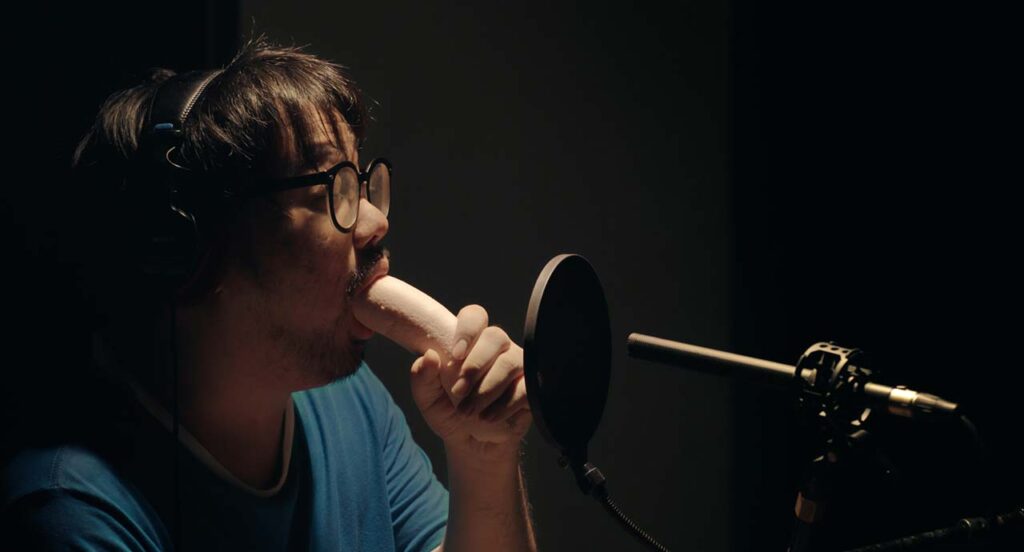Structuring Comedy (I): Death of The Sound Man
In this two-part series, Joshua Ng examines how two shorts from the Southeast Asian Short Film Competition use comedy in two very different ways.

Death of the Sound Man emphatically announces its genre from the get-go: this is a comedy. And not one of those comedies that tickle the mind and not much else. This one aims straight for our bellies; it demands us to laugh.
That much is evident from the opening scene, which sees foley artist Nicky sucking off a sausage to create sound effects for a pornographic scene, only to be handed a thicker sausage when fellow sound man Burt finds his work lacking.
This crude humour wasn’t what I expected from a festival film, but I was instantly hooked, just wanting and waiting for the next joke.
And waiting.
And waiting and waiting and waiting.
Director Sorayos Prapapan makes us wait till the very end for the only other comedic set piece. Meanwhile, we are treated to the heavy-handed ramblings of our two Thai soundmen.
They explicitly voice their dissatisfaction with their government’s spending and the rising cost of living. Their biggest gripe is implied through a simplistic analogy – their government doesn’t listen to them, just as nobody listens to the sound in movies anymore.

“It seems that no one listens to what we’re doing.”
“Um, that’s true. No one cares about our sound.”
This conversation plays over a protracted shot of a sleeping cheetah, before cutting to the Equestrian statue of King Chulalongkorn. If that wasn’t obvious enough, the film shoves another 7 statues of Thai kings in our faces.
It’s an obvious metaphor, but it works purely due to the film’s bait-and-switch. By casting his film as a comedy within the opening minute, Prapapan first whets our appetite for comedy before feeding us his complaints. And we gladly take this bitter pill, driven by our hunger for the next joke.
We forgive the blunt exposition because we believe it is building to a punch line that never really comes. Two entire scenes pass without a single joke until we reach the satirical epilogue, which also incorporates thinly-veiled political commentary. But we forgive this too because it’s a genuinely funny scene.
Such is the nature of comedy. It tolerates coincidences, deus ex machina endings and, in this case, heavy-handed exposition. Prapapan is keenly aware that framing this film as a comedy modifies audience expectations and he masterfully exploits that to voice his frustrations more directly than he could in a drama.
Some might call this lazy storytelling; I would call it effective.
The frankness of the film’s message matches the message itself. If Prapapan truly wants Thailand to recognise the inattentiveness of their government, it would be inauthentic to bury said message under layers of abstraction. Instead, he suitably chose comedy and candour as the tools of his trade.
That’s not to say that the film is sans subtleties. Another subtlety that made me chuckle was the scene with Burt musing that “no one cares about our sound”, while a sleeping cheetah twitches its ear without waking up. Maybe someone does hear the voice of the people. They just don’t care.
As bitter as his complaints may be, it’s clear that Prapapan is optimistic for more than a twitch from the government as the Thai people regain their voice. He concludes his masterpiece with a bang – a storm approaches. A sound board comes to life in a dance. The film closes with an anthem for the future, the only piece of music in the entire film.

Death of the Sound Man doesn’t propose any answers, but then again, it’s not the place of satire to suggest solutions; its role is to point out issues in society. But what’s the point of complaining if no one is listening? Prapapan is acutely aware of this and coats his complaints in comedy to make it more palatable to the masses.
Of all the Southeast Asian shorts in competition this year, Death of the Sound Man is by far the most comical. Although the genre is recognised in many cultures for its capability to critique, it still remains the domain of Western cinema. I’m excited and encouraged to see Southeast Asian filmmakers operate in this notoriously difficult mode. The world of comedy could benefit from new voices.
After all, as Burt says in the film, we can’t keep using the same sounds in the movies. Just as cinemagoers demand new sounds to be satisfied, we too must champion new voices in Southeast Asian cinema.
In Part 2 of this series, Joshua analysed the use of comedy in Nelson Yeo’s Five Trees.

